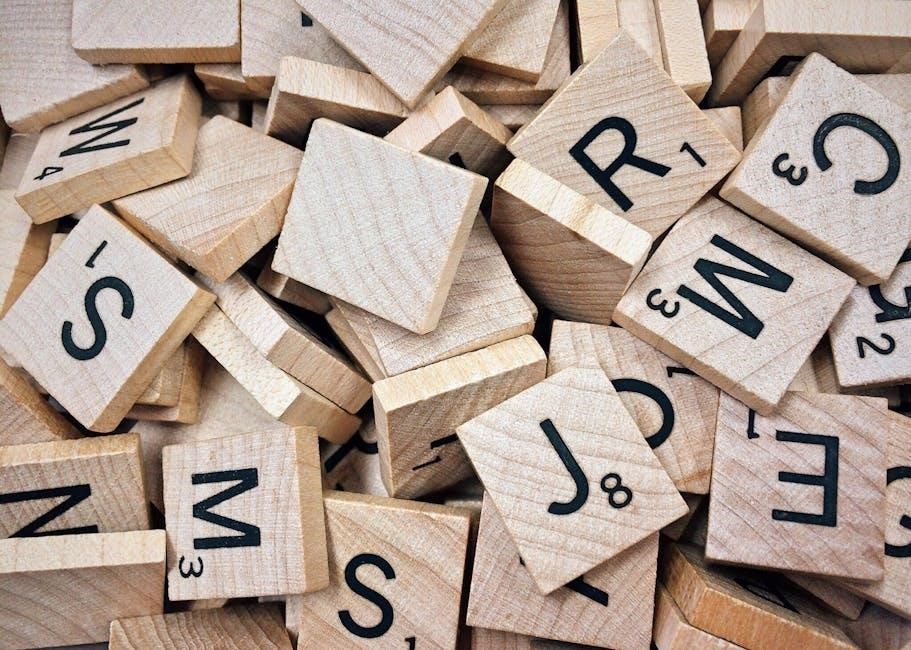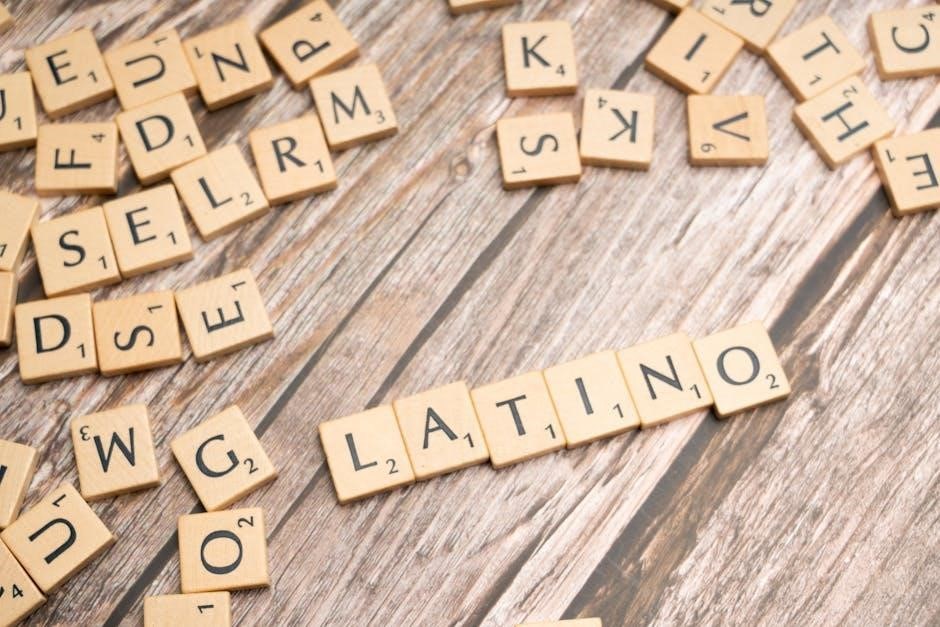spanish alphabet pdf
The Spanish alphabet is a foundational tool for learning the language, consisting of 27 letters․ PDF resources offer charts, pronunciation guides, and exercises to help learners master the alphabet effectively․

Overview of the Spanish Alphabet
The Spanish alphabet is composed of 27 letters, including all 26 letters of the English alphabet plus the additional letter Ñ․ This structured system is essential for learning Spanish pronunciation and spelling․ The alphabet is organized into vowels and consonants, with vowels being A, E, I, O, U, and sometimes Y․ Consonants include unique sounds like Ch and Ll, which are treated as single letters․ PDF resources provide detailed charts, pronunciation guides, and examples to help learners master the alphabet․ These materials often include audio recordings, memorization tips, and practice exercises․ The Spanish alphabet is a fundamental tool for language acquisition, and its clear structure makes it accessible for learners of all levels․ PDF guides are particularly useful for visual learners, offering a comprehensive overview of each letter and its corresponding sounds․
Importance of Learning the Spanish Alphabet
Mastering the Spanish alphabet is crucial for building a strong foundation in the language․ It aids in proper pronunciation, spelling, and comprehension․ Without understanding the alphabet, learners struggle with basic communication․ PDF resources, such as charts and guides, provide clear examples and pronunciation tips, making learning efficient․ The alphabet’s structure introduces unique letters like Ñ, Ch, and Ll, which are vital for distinguishing sounds․ Early mastery enhances vocabulary acquisition and grammar skills․ Additionally, familiarizing oneself with the Spanish alphabet facilitates effective communication in both spoken and written forms․ Many educational tools, including PDFs, offer interactive exercises and flashcards to reinforce learning․ By prioritizing the Spanish alphabet, learners ensure a smoother transition into more complex aspects of the language, making it an essential first step in their linguistic journey․
Structure of the Spanish Alphabet
The Spanish alphabet is based on the Latin script and consists of 27 letters, including vowels, consonants, and unique characters․ It closely resembles the English alphabet but includes additional letters such as Ñ, Ch, and Ll, which are considered single units․ The structure is organized alphabetically, with each letter having a distinct name and pronunciation․ For example, the letter A is pronounced “ah,” B as “bay,” and C as “ce․” Unique letters like Ñ (eñe) and Ll (doble ele) are integral to the Spanish language and distinguish it from other Latin-based alphabets․ The alphabet’s arrangement and pronunciation guides are often presented in PDF charts and educational resources, making it easier for learners to understand and memorize the sequence and sounds of each letter effectively․

Spanish Alphabet Pronunciation
The Spanish alphabet includes 27 letters, with each having a distinct pronunciation․ Vowels and consonants follow phonetic rules, making pronunciation predictable․ PDF charts provide examples and guides for accurate learning․
Vowels in the Spanish Alphabet
The Spanish alphabet contains five primary vowels: A, E, I, O, U․ These letters form the core of Spanish pronunciation, with each having a consistent sound․ Unlike English, Spanish vowels are pronounced similarly across different words, making them easier to learn․ For example, the letter A is always pronounced like the “a” in “father,” while E sounds like the “e” in “bet․” The vowels I, O, U follow the same rule, with I sounding like “ee” in “see,” O like “o” in “go,” and U like “oo” in “boot․” PDF resources provide charts and exercises to practice these sounds, ensuring mastery of Spanish vowel pronunciation․
Consonants in the Spanish Alphabet
The Spanish alphabet includes 22 consonants, each with distinct pronunciation rules․ Letters like B and V are pronounced similarly but differ in sound, with B sounding like “b” in “boy” and V like “b” but with lips closer together․ The letter C can be soft (like “s” in “city”) or hard (like “k” in “cat”), depending on the following vowel․ Other consonants, such as Ch and Ll, represent unique sounds, with Ch sounding like “ch” in “church” and Ll like “y” in “yes․” PDF resources provide detailed charts and exercises to practice these sounds, ensuring learners grasp the differences between similar consonants․
Spanish consonants generally have consistent pronunciation, making them easier to learn than English․ For example, H is always silent, while R is rolled․ PDF guides often include word examples and drills to help master these sounds effectively․
Special Sounds in the Spanish Alphabet
The Spanish alphabet features unique sounds that distinguish it from other languages, such as the letters Ñ, Ch, and Ll․ The letter Ñ (pronounced “ny” like in “canyon”) is exclusive to Spanish and represents a distinct sound․ The letters Ch and Ll are treated as single consonants: Ch sounds like “ch” in “church,” while Ll resembles the “y” in “yes․” These special sounds are crucial for proper pronunciation and are often highlighted in PDF resources․ For example, the letter Ñ is used in words like “señor,” Ch in “ocho,” and Ll in “llama․” Spanish alphabet PDFs provide detailed pronunciation guides and exercises to help learners master these unique sounds․ These resources also offer word examples and drills, ensuring learners can practice and understand the correct usage of these special letters in real contexts․

Unique Letters in the Spanish Alphabet
The Spanish alphabet includes unique letters like Ñ, Ch, Ll, and H, which don’t exist in English․ PDF resources provide detailed guides for pronunciation and practice of these distinctive letters․
The Letter Ñ (Eñe)
The letter Ñ, called “eñe,” is a unique character in the Spanish alphabet․ It represents a distinct sound, similar to the “ny” in “canyon․” PDF resources highlight its pronunciation and usage․ For example, words like “mañana” (tomorrow) and “señor” (Mr․) showcase its importance․ Learning Ñ is essential for accurate spelling and pronunciation in Spanish․ PDFs provide exercises and examples to practice this letter effectively․ Additionally, downloadable charts and flashcards in PDF format offer visual aids to reinforce its use․ Mastering Ñ enhances language proficiency and helps learners recognize its role in Spanish vocabulary․ Regular practice with PDF materials ensures familiarity and correct application of this special letter․
The Letters Ch and Ll
The letters Ch and Ll are unique in the Spanish alphabet, representing distinct sounds․ Ch is pronounced like the “ch” in “church,” while Ll sounds like the “y” in “play․” These digraphs are treated as single letters in Spanish․ PDF resources provide clear examples, such as “ocho” (eight) for Ch and “llama” (llama) for Ll․ Practicing these letters is crucial for accurate pronunciation and spelling․ Spanish alphabet PDFs often include exercises and flashcards to help learners master Ch and Ll․ These materials highlight their importance in words like “chico” (boy) and “lluvia” (rain)․ Understanding Ch and Ll enhances language skills and helps differentiate similar-sounding words․ Regular practice with PDF guides ensures learners can recognize and use these letters confidently in everyday Spanish vocabulary․
The Letter H (Hache)
The letter H, known as “hache” in Spanish, is a consonant in the Spanish alphabet․ Unlike in English, the Spanish H is always silent and does not produce a sound․ For example, in words like “hola” (hello) or “hambre” (hunger), the H is not pronounced․ This unique feature can be confusing for learners, especially those familiar with the voiced H in English․ PDF resources, such as Spanish alphabet charts and pronunciation guides, emphasize this silent characteristic․ Flashcards and worksheets often include words with H to help learners practice and memorize its correct usage․ Understanding the silent H is essential for accurate pronunciation and spelling in Spanish․ PDF materials provide clear examples and exercises to reinforce this concept, ensuring learners can recognize and use the letter H effectively in various contexts․ Regular practice with these resources helps solidify the correct pronunciation of H in Spanish vocabulary․

Differences from the English Alphabet
The Spanish alphabet includes 27 letters, adding ñ, ch, and ll, while excluding some English letters․ PDF resources highlight these unique letters and their pronunciation guides for clarity․
Additional Letters in the Spanish Alphabet
The Spanish alphabet includes three additional letters not found in the English alphabet: ñ, ch, and ll․ These letters are unique to Spanish and have distinct pronunciation guides․ PDF resources provide detailed charts and examples to help learners understand and practice these letters․ For instance, ñ is pronounced like the “ny” in “canyon,” while ch sounds similar to the “ch” in “church․” The ll, often referred to as “doble ele,” has a pronunciation that can vary by region, ranging from a soft “j” sound to a “y” sound․ These letters are essential for proper spelling and pronunciation in Spanish, and PDF guides offer exercises to master their use․ By studying these additional letters, learners can improve their overall proficiency in the language․ These resources are invaluable for both beginners and advanced students alike, ensuring a comprehensive understanding of the Spanish alphabet․
Similarities Between Spanish and English Alphabets
The Spanish and English alphabets share 22 of the same letters, making it easier for English speakers to learn Spanish․ Most of these shared letters have identical or very similar pronunciation․ For example, vowels like A, E, I, O, U are pronounced similarly in both languages․ Consonants such as B, C, D, and F also have comparable sounds, simplifying the learning process․ This overlap provides a strong foundation for learners to build upon․ However, some consonants like H and G have different pronunciation rules in Spanish․ PDF resources often highlight these similarities, offering charts and flashcards to help learners compare and practice․ These tools emphasize the shared structure, making it easier to focus on the unique aspects of the Spanish alphabet․ By leveraging these similarities, learners can accelerate their mastery of the Spanish language․

Spanish Alphabet PDF Resources
Spanish alphabet PDF resources provide comprehensive tools for learners, including charts, guides, and flashcards․ These materials offer clear pronunciation tips, letter examples, and practice exercises․ PDFs are ideal for offline learning, featuring printable charts that display all 27 letters with their names and sounds․ Many resources include interactive elements like quizzes and worksheets to enhance engagement․ Flashcards in PDF format allow learners to test their knowledge effectively․ Additionally, specialized PDFs focus on unique letters like Ñ and Ch, offering detailed memorization techniques․ These resources cater to all learning styles, making them indispensable for mastering the Spanish alphabet efficiently․ They are widely available online, ensuring accessibility for anyone looking to learn or teach the Spanish language․
Downloadable Spanish Alphabet Charts
Downloadable Spanish alphabet charts are essential tools for learning the language․ These charts typically include all 27 letters, their names, and pronunciation guides․ Many PDF charts feature uppercase and lowercase letters, along with example words to illustrate sounds․ They often highlight unique letters like ñ, ch, and ll, which are distinct to Spanish․ Some charts also include audio recordings or visual aids to help with pronunciation․ Printable charts are ideal for classroom use or self-study, offering a clear and organized way to memorize the alphabet․ They are widely available online and can be customized to suit different learning needs; For example, some charts focus on pronunciation tips, while others include spelling exercises․ These resources are particularly useful for beginners, as they provide a visual and interactive way to master the Spanish alphabet․
Spanish Alphabet Worksheets for Practice
Spanish alphabet worksheets are invaluable resources for mastering the language․ Designed for hands-on learning, these PDF documents offer a variety of exercises to practice letter recognition, pronunciation, and spelling․ Worksheets often include activities such as matching letters to sounds, writing practice, and spelling exercises․ Many feature interactive elements like crossword puzzles or word searches to make learning engaging․ They are particularly useful for beginners, as they provide a structured approach to memorizing the 27-letter Spanish alphabet․ Worksheets may also include visual aids, such as pictures or example words, to help learners associate letters with sounds․ Available in both uppercase and lowercase formats, these resources cater to all skill levels, from children to adults․ By using these worksheets, learners can reinforce their understanding of the Spanish alphabet and build a strong foundation for further language study․
Interactive Spanish Alphabet Guides
Interactive Spanish alphabet guides offer a dynamic way to learn the language․ These resources, often available in PDF format, incorporate clickable features, audio clips, and multimedia elements to enhance engagement․ Learners can click on letters to hear their pronunciation, view animations, or participate in quizzes․ Many guides include interactive exercises, such as matching games or drag-and-drop activities, to practice letter recognition and spelling․ Audio recordings of native speakers are frequently embedded, allowing learners to mimic pronunciations accurately․ These guides also often include progress-tracking tools, enabling users to monitor their improvement․ Designed for both children and adults, interactive Spanish alphabet guides make learning fun and effective․ They are particularly useful for self-study, as they provide immediate feedback and reinforce retention of the 27-letter Spanish alphabet․ By combining visual, auditory, and hands-on learning, these guides cater to diverse learning styles and preferences․
Spanish Alphabet Flashcards in PDF Format
Spanish alphabet flashcards in PDF format are a popular and effective tool for learning the 27-letter Spanish alphabet․ These flashcards typically feature a letter on one side and its pronunciation, name, and sometimes an example word on the other․ Many PDF flashcards are designed with colorful visuals and clear layouts, making them engaging for learners of all ages․ They often include pronunciation guides, such as A (ah) or B (be), to help learners memorize the sounds․ Some flashcards also provide tips for distinguishing similar letters, like B and V, which can be confusing for beginners․ Interactive PDFs may include clickable features or audio clips, while printable versions allow learners to physically flip through the cards․ Flashcards are particularly useful for memorization and can be easily shared or downloaded for practice on the go․ They are a versatile resource for anyone looking to master the Spanish alphabet efficiently․

Learning Tips for the Spanish Alphabet
Mastering the Spanish alphabet starts with consistent practice․ Use PDF charts and flashcards to memorize letters and their sounds․ Practice pronunciation daily and apply spelling exercises for better retention and fluency․
Memorization Techniques for the Spanish Alphabet
Effective memorization of the Spanish alphabet begins with breaking it into manageable parts․ Start by grouping letters into vowels and consonants․ Use flashcards to associate each letter with its name and sound, enhancing visual and auditory memory․ Another technique is creating mnemonics or rhymes to link letters together․ For example, associating the letter “A” with the pronunciation “ah,” as in “father,” helps in retaining it․ Additionally, write each letter repeatedly, paying attention to its shape and sound․ Utilize PDF charts and printable worksheets for structured practice․ Regular repetition and spaced intervals reinforce memory․ Incorporate songs or videos that teach the alphabet, as music aids in long-term retention․ Finally, apply the letters in real contexts by spelling simple words, making the learning process both practical and engaging․
Pronunciation Practice Exercises
Mastering Spanish pronunciation begins with targeted exercises․ Start by listening to native speakers and mimicking their intonation․ Focus on individual sounds, such as the sharp “t” in “taco” or the soft “c” in “cerveza․” Use PDF charts to identify and practice challenging sounds like “ñ” or “ll․” Record yourself repeating letters and words, then compare your pronunciation to native examples․ Practice spelling aloud, paying attention to syllable stress․ Flashcards with words on one side and their phonetic pronunciations on the other can enhance your learning․ Regularly review and repeat sounds, gradually increasing speed․ Incorporate simple sentences to apply pronunciation in context․ Consistent practice ensures accurate and confident speech․
Using Flashcards for Effective Learning
Flashcards are a versatile tool for mastering the Spanish alphabet․ Create physical or digital cards with a letter on one side and its pronunciation on the other․ For vowels, include words like “a” (ah) and “e” (eh) to aid recognition․ For consonants, highlight tricky sounds such as “ch” (che) and “ll” (doble ele)․ Use blank flashcards to practice writing letters, reinforcing muscle memory․ Shuffle cards regularly to test readiness․ Incorporate images for visual learners, linking letters to common words․ Track progress by categorizing cards into “mastered” and “needs practice․” Utilize apps for interactive sessions and spaced repetition․ Flashcards make learning engaging and mobile, ensuring consistent practice and retention․ They are especially effective for memorizing the 27-letter Spanish alphabet, including unique letters like “ñ” and “ü․” Regular use enhances both recognition and recall, building a strong foundation for language skills․
Spelling Exercises for Mastery
Spelling exercises are essential for mastering the Spanish alphabet․ Start by writing each letter repeatedly, focusing on correct formation․ Practice spelling common words like “hola” (hello) and “gracias” (thank you)․ Use fill-in-the-blank exercises to test recognition, such as completing missing letters in words like “c____o” (perro)․ Crossword puzzles and word scrambles also enhance spelling skills․ For example, unscramble “taeos” to form “ostras․” Flashcard drills with words on one side and definitions on the other reinforce memory․ Dictation exercises, where you write words spoken aloud, improve accuracy․ Group letters into categories, like vowels and consonants, to simplify learning․ Track progress by maintaining a spelling journal․ Regular practice builds confidence and fluency in spelling Spanish words․ Downloadable PDF worksheets provide structured exercises for consistent practice and mastery of the Spanish alphabet․

Cultural Significance of the Spanish Alphabet
The Spanish alphabet is a cornerstone of Hispanic heritage, reflecting the language’s rich history and cultural identity․ It shapes communication, literature, and daily life, preserving traditions and regional linguistic diversity․
Historical Development of the Spanish Alphabet
The Spanish alphabet has evolved significantly over centuries, influenced by Latin, Arabic, and regional dialects․ Originating from the Latin script, it adapted to Spanish phonetics, incorporating unique letters like ñ and ch․ Historical documents reveal that the modern Spanish alphabet, comprising 27 letters, was formalized in the 18th century by the Real Academia Española․ This standardization ensured linguistic unity across Spanish-speaking regions․ The inclusion of diacritical marks and special sounds reflects the language’s adaptability․ Today, the Spanish alphabet is widely used in education and communication, preserving cultural identity and historical roots․ Its development mirrors the rich linguistic diversity of Spain and Latin America, making it a vital tool for language learners and cultural enthusiasts alike․
Regional Variations in Pronunciation
Spanish pronunciation varies across regions, with distinct accents and intonation․ In Spain, the pronunciation of letters like z and c (before e or i) is sibilant, while in Latin America, these sounds are pronounced with a voiceless alveolar fricative․ The letter ll is pronounced as a voiced palatal stop in some regions, while in others, it sounds like j․ Vowel pronunciation remains relatively consistent, but stress and rhythm differ, such as the faster speech in Caribbean regions compared to the slower, melodic intonation in southern Spain․ Such variations enrich the Spanish language, reflecting cultural diversity․ Understanding these differences is key to mastering pronunciation and communicating effectively across Spanish-speaking regions․
The Role of the Spanish Alphabet in Language Learning
The Spanish alphabet plays a crucial role in language learning as it forms the basis of reading, writing, and pronunciation․ PDF resources, such as charts and guides, provide learners with a clear and structured way to master the 27-letter alphabet․ These tools often include pronunciation tips, letter names, and examples, making them indispensable for beginners․ Consistent practice with these materials helps learners recognize and reproduce sounds accurately, ensuring proper spelling and intonation․ Additionally, Spanish alphabet PDFs often include exercises and flashcards, which reinforce memorization and application․ By mastering the alphabet, learners gain the ability to decode words, understand syllable division, and grasp pronunciation rules․ This foundational skill is essential for progressing in Spanish, as it directly impacts vocabulary acquisition and overall language proficiency․ Thus, the Spanish alphabet is not just a starting point but a cornerstone of effective language learning․
Mastering the Spanish alphabet is essential for language proficiency․ Utilize PDF resources like charts and flashcards to practice consistently and enhance your learning journey․
Final Thoughts on the Spanish Alphabet
The Spanish alphabet is a fundamental cornerstone for mastering the Spanish language․ With 27 letters, including unique ones like ñ, ch, and ll, it provides a clear structure for pronunciation and spelling․ Utilizing PDF resources such as charts, flashcards, and worksheets can significantly enhance learning․ These tools offer visual aids and interactive exercises, making the process engaging and effective․ Consistent practice, whether through repetition or practical application in sentences, is key to fluency․ Additionally, understanding the cultural context and historical evolution of the alphabet enriches the learning experience․ By dedicating time to study and practice, learners can confidently navigate the Spanish language, unlocking countless opportunities for communication and connection․ Remember, mastery takes time, so stay consistent and celebrate every small achievement along the way․
Encouragement for Further Practice
Mastering the Spanish alphabet is a rewarding journey that opens doors to a rich linguistic and cultural heritage․ Consistent practice, even for a few minutes daily, significantly enhances fluency and confidence․ Utilize the variety of PDF resources available, such as flashcards, worksheets, and interactive guides, to make learning engaging and enjoyable․ These tools not only reinforce letter-sound associations but also provide opportunities to apply knowledge through exercises like spelling, pronunciation drills, and word formation․ Embrace the process, celebrate small victories, and explore how each letter contributes to the beauty of the Spanish language․ Remember, practice is key to unlocking the full potential of the Spanish alphabet, so stay motivated, stay curious, and enjoy the journey of learning this beautiful language․